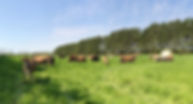


COWS and the ENVIRONMENT
Cattle get a lot of bad press these days but the existence of large ruminants on Earth is not accidental or a tragic mistake. In fact, when allowed to occupy the ecological niche they were designed for, these animals play critical roles in sequestering carbon in the soil and converting grasses from a natural landscape into high quality nutrition for humans. Environmental concerns were one of our main reasons for adopting grazing over thirty years ago. Our mixed pastures of grasses, legumes, and deep rooted forbs protect water quality by keeping the ground covered and scavenging nutrients while managed grazing means these plants are pulling carbon dioxide out of the air and building organic matter in the soil. Trees buffer the ditches and streams, matching herd size to the carrying capacity of the land avoids buildup of excess nutrients. We do our best to mimic a natural ecosystem, creating a landscape that our cattle share with numerous other mammals, birds, reptiles, and amphibians, so that the whole farm, rather than just a strip here or a patch there, provides environmental benefits and wildlife habitats.


